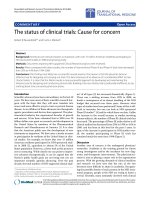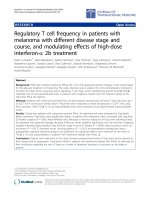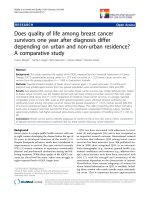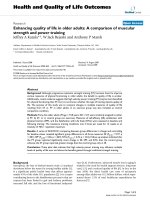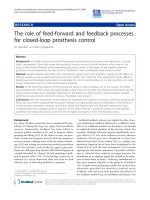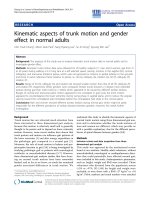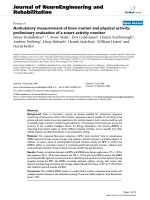báo cáo hóa học: " Enhancing quality of life in older adults: A comparison of muscular strength and power training" pot
Bạn đang xem bản rút gọn của tài liệu. Xem và tải ngay bản đầy đủ của tài liệu tại đây (301.62 KB, 8 trang )
BioMed Central
Page 1 of 8
(page number not for citation purposes)
Health and Quality of Life Outcomes
Open Access
Research
Enhancing quality of life in older adults: A comparison of muscular
strength and power training
Jeffrey A Katula*
†
, W Jack Rejeski and Anthony P Marsh
Address: Department of Health & Exercise Science, Wake Forest University, Winston-Salem, NC, USA
Email: Jeffrey A Katula* - ; W Jack Rejeski - ; Anthony P Marsh -
* Corresponding author †Equal contributors
Abstract
Background: Although progressive resistance strength training (ST) has been found to improve
various measures of physical functioning in older adults, the benefit to quality of life is unclear.
Additionally, recent evidence suggests that high velocity power training (PT) may be more beneficial
for physical functioning than ST, but it is not known whether this type of training impacts quality of
life. The purpose of this study was to compare changes in multiple measures of quality of life
resulting from ST vs. PT in older adults. A no exercise group was also included as control
comparison condition.
Methods: Forty-five older adults (M age = 74.8 years; SD = 5.7) were randomly assigned to either
a) PT, b) ST, or c) control group (no exercise). Measures of self-efficacy (SE), satisfaction with
physical function (SPF), and the Satisfaction with Life Scale (SWL) were assessed at baseline and
following training. The resistance training conditions met 3 times per week for 12 weeks at an
intensity of 70% 1 repetition maximum.
Results: A series of ANCOVA's comparing between group differences in change and controlling
for baseline values revealed significant group differences in all three measures: SE (F
(2,31)
= 9.77; p
< .001); SPF (F
(2,32)
= 3.36; p = .047); SWL (F
(2,31)
= 4.76; p = .016). Follow up analyses indicated that
the PT group reported significantly more change in SE, SPF, and SWL than the control group
whereas the ST group reported greater change than the control group only in SE.
Conclusion: These pilot data indicate that high velocity power training may influence multiple
levels of quality of life over and above the benefits gained through traditional strength training.
Background
Sarcopenia, the loss of skeletal muscle mass <2 standard
deviations below the mean for young healthy adults [1],
is a significant public health issue that affects approxi-
mately 45% of the older U.S. population [2]. It is a major
contributing factor to the disablement process in that sar-
copenia has been linked to gait and balance problems,
increased fall risk, and the loss of functional independ-
ence [3,4]. Furthermore, advanced muscle loss in aging is
related to the need for health support services, long-term
care [1,5], and a reduced quality of life [6]. In fact, in the
year 2000, the direct health care costs of sarcopenia
among older adults was 18.2 billion dollars, which repre-
sented about 1.5% of total healthcare expenditures for
that year [7].
Published: 13 June 2008
Health and Quality of Life Outcomes 2008, 6:45 doi:10.1186/1477-7525-6-45
Received: 31 August 2007
Accepted: 13 June 2008
This article is available from: />© 2008 Katula et al; licensee BioMed Central Ltd.
This is an Open Access article distributed under the terms of the Creative Commons Attribution License ( />),
which permits unrestricted use, distribution, and reproduction in any medium, provided the original work is properly cited.
Health and Quality of Life Outcomes 2008, 6:45 />Page 2 of 8
(page number not for citation purposes)
Although sarcopenia has been found to be related to
increasing age, it is not an inevitable component of the
aging process and several risk factors are modifiable.
Research indicates that sarcopenia is associated with lung
disease [1], hormone levels [6], inadequate dietary pro-
tein intake [8], inflammation (measured by IL-6 and other
cytokines) [4], and physical activity. Indeed, several rand-
omized controlled trials have demonstrated that strength
training (ST) can safely increase muscle mass and strength
in older adults and improve physical function [for reviews
see [9,10]]. Additionally, recent evidence [11] suggests
that high velocity resistance training, or power training
(PT), can result in significantly greater increases in muscle
power compared to traditional ST and can significantly
improve mobility related outcomes [12].
However, despite the well documented benefits of
strength training on physical function, evidence examin-
ing the influence of ST on quality of life or quality of life
in older adults is equivocal. For example, one study of car-
diac rehabilitation patients (n = 38; M
age = 59 years; SD
= 12) found that twelve weeks of high intensity ST signif-
icantly improved several indices of quality of life, includ-
ing self-efficacy, mood, physical function, pain, vitality,
and role emotional health [13]. In contrast, Chin and col-
leagues (n = 173; M age = 81 years; SD = 5.4) [14] and
Damush and Damush (n = 62; M age = 68 years; SD = 5.6)
[15] found ST to have no effect on quality of life in older
adults. Moreover, a recent comprehensive review of 62 tri-
als examining the effects of ST on physical disability in
older adults concluded that ST had no influence on pain,
a global index of health-related quality of life, or vitality
[9]. To our knowledge, there are no existing data concern-
ing the effects of PT on quality of life.
Therefore, the purpose of this study was to compare the
effects of ST and PT to one another and to a wait list con-
trol group with respect to changes in quality of life in
older adults. Following Stewart and King's [16] concep-
tual framework of quality of life (QOL), we view QOL as
consisting of both function and well-being. Furthermore,
well-being consists of both proximal outcomes of physical
activity as well as more global constructs [17,18]. There-
fore, consistent with recommendations of Diener [19]
and Rejeski and Mihalko [18], we chose to conceptualize
QOL as consisting of multiple components of varying lev-
els of specificity: satisfaction at both the global level (i.e.,
satisfaction with life) and domain level (i.e., satisfaction
with physical function). We also chose to include a situa-
tion specific measure of self-efficacy as this construct has
been found to be an important predictor of satisfaction
with life [17] and to gauge activity-specific effects. There-
fore, in this conceptual model one would expect resist-
ance training to impact proximal, activity specific
measures (self-efficacy), measures specific to functional
domain (satisfaction with physical function), and global
well-being (satisfaction with life).
Methods
Design
This study was a randomized, controlled 12-week trial
that involved three different treatment conditions: PT, ST,
or a wait-list control group. Older adults were randomly
assigned to one of the three study arms following screen-
ing and baseline testing. The outcomes for this study
included a global measure of quality of life, the satisfac-
tion with life scale [20], a satisfaction index specific to
physical functioning [21], and a self-efficacy measure that
assessed perceived capability to lift different amounts of
weight [22]. The present study was part of a larger pilot
study examining the influence of ST vs. PT on muscle
strength, muscle power, and physical functioning.
Participants
Older adults were recruited from the local community
using flyers distributed to retirement communities, a data-
base containing the names of older adults interested in
clinical trials research, and advertisements placed in the
local newspaper. We were primarily interested in targeting
older adults with impaired lower extremity functioning.
Therefore, an inclusion criterion included self-reported
difficulty with at least one of the following: walking a
quarter mile, climbing stairs, getting in and out of a car,
rising from a chair, lifting and carrying groceries, getting
out of bed, getting out of the bathtub, or performing
shopping, cleaning, or self-care activities. Additional eligi-
bility criteria for participation were: age 65 years or older,
community dwelling, and capable of walking unassisted
or with a cane. Respondents were excluded if they were
moving from the area within one year, under hospice care,
receiving active treatment for cancer (other than skin can-
cer), had shortness of breath or chest pain at rest, myocar-
dial infarction in the past 6 months, had a MMSE [23]
score < 24, upper or lower extremity amputation, unstable
CVD, severe CHF, stroke, peripheral vascular disease,
CAD, valvular heart disease, major psychiatric disease
(self-reported controlled depression was not an exclu-
sion), severe anemia, liver or renal disease, uncontrolled
diabetes or hypertension, orthopedic impairment, blind-
ness or deafness, upper or lower extremity fracture within
the past 6 months, consumption (current or within pro-
ceeding 2 months, > 2 drinks per day), current participa-
tion in regular exercise sessions ("Do you currently walk
for at least 30-minutes at a time more than 1 time a
week?"), or were currently participating in a research
study.
A brief pre-screening questionnaire to assess demograph-
ics, health status, and self-reported disability was admin-
istered to all respondents via telephone. Persons who
Health and Quality of Life Outcomes 2008, 6:45 />Page 3 of 8
(page number not for citation purposes)
passed the pre-screening were invited to the laboratory for
a detailed screening for health and self-reported disability.
Respondents meeting the eligibility criteria, who received
written approval from their primary care physician, and
who passed a resistance training safety screening (see
below), were considered eligible for the study. The flow of
participants through the study is illustrated in Figure 1.
This study was approved by the university IRB and all par-
ticipants gave written informed consent.
Measures
Self-efficacy for Strength (SE)
Self-efficacy for strength was assessed in a hierarchical
manner consistent with Bandura's [24] recommenda-
tions. Participants rated their confidence in their ability to
successfully complete ten repetitions of increasing
amounts of weight (5 items, 10 pounds up to 50 pounds
in 10 pound increments). Items were scored on a scale of
0 to 100 and then averaged across the five items. Higher
scores reflected greater self-efficacy for strength. This
methodology has been used in numerous exercise studies
and has been shown to be a valid and reliable method for
assessing self-efficacy [25]. This scale demonstrated ade-
quate reliability in the present study with Crobach alpha's
of .82 and .92 at baseline and follow up, respectively.
Satisfaction with Physical Function (SPF)
Participants rated their satisfaction with six aspects of gen-
eral physical function (e.g., level of physical fitness, level
of endurance or stamina, physical ability to do what you
want or need to do) on a 7-point scale ranging from +3 to
-3: -3 (very dissatisfied), -2 (somewhat dissatisfied), -1 (a
little dissatisfied), 0 (neutral), +1 (a little satisfied), +2
(somewhat satisfied), and +3 (very satisfied) [21]. Items
were summed and averaged to obtain a total SPF score.
This scale has been found to possess adequate psychomet-
ric properties [21]. This scale demonstrated adequate
internal consistency in the present study (α's = .91 94).
Life Satisfaction
The Satisfaction With Life Scale (SWLS) [20] was used to
assess global quality of life. This measure was designed to
assess an individual's global judgment of life satisfaction
by allowing the respondent to weight the importance of
life domains in accordance with his or her own values.
The SWLS is a 5-item scale with each scale item rated on a
7-point scale ranging from 1 (strongly disagree) to 7
(strongly agree), with higher scores representing greater
life satisfaction. Reviews of research using the SWLS sug-
gest that it is sensitive enough to detect changes in life sat-
isfaction over time [26]. The SWLS has adequate internal
consistency and validity in research on aged populations
and has been found to be responsive to physical activity
in older adults [17,27]. The SWLS demonstrated adequate
internal consistency in the present study (α's = .84 88).
Procedures
As a safety precaution, all participants completed a resist-
ance training screening consisting of a series of lower
extremity resistance exercises while heart rate (12 lead
ECG), blood pressure, and symptoms were monitored.
The data were reviewed by a physician who looked for
abnormalities in heart rate and blood pressure. No partic-
ipants were excluded based on the results of this screening
procedure.
Data Collection
Participants attended a baseline data collection visit in our
laboratory in which basic demographic and biometric var-
iables were assessed. In addition to age, gender, and edu-
cation level, participants were assessed for body mass and
height. Body Mass Index (BMI) was calculated using val-
ues of body mass and height. Muscle power and strength
Participant Flow DiagramFigure 1
Participant Flow Diagram.
Respondents (n = 309)
Telephone Screenings (n = 232)
Medical Screenings (n = 48)
Randomized
(
n = 45
)
Ineligible (n = 178)
In other study (n = 22)
Not interested (n = 32)
Too fit (n = 66)
Other non-medical (n = 25)
Medical screen fail (n = 27)
No reason provided (n = 7)
Wait list
(
n = 6
)
Ineligible (n = 3)
1 Knee surgery
1 MMSE < 24
1 Unwilling to commit to study
Strength Training
(n = 15)
Power Training
(n = 15)
Control
(n = 15)
Lost to follow-up
(n = 2)
1 spinal stenosis
1 work schedule
Lost to follow-up
(n = 4)
1 aortic aneurysm
1 lung cancer
1 back pain
1 no follow up testing
Lost to follow-up
(n = 3)
1 surgery
1 fall
1 no follow-up
testin
g
Completed Study (n = 36)
Health and Quality of Life Outcomes 2008, 6:45 />Page 4 of 8
(page number not for citation purposes)
were assessed using pneumatic leg press (LP) and knee
extension (KE) machines (Keiser Sports Health Equip-
ment, Fresno, CA). These machines were also used for all
power and strength training. The protocols and validation
have been described previously [28]. Data collectors were
not blinded to treatment arm allocation.
PT and ST Interventions
The PT and ST interventions were conducted on Keiser
pneumatic resistance machines that allowed fast and slow
movement speeds without the risk of dropping weights or
weight stacks. Training occurred at a central location and
all sessions were supervised by an unblinded, trained
interventionist. All participants attended an orientation
session where the equipment and exercises were demon-
strated. Participants trained in small groups (7–8 individ-
uals) and rotated through the exercises stations.
Participants in the power training group trained at a sepa-
rate time than the strength training group. Although the
focus of the intervention was the lower extremity, we
included several upper body ST exercises using dumbbells
(chest press, bicep curl, tricep kickback) and Nautilus
machines (overhead shoulder raise, seated row). Partici-
pants completed three training sessions per week for 12
weeks. In each session participants completed three sets of
8–10 repetitions on the bilateral leg press (LP) and knee
extension (KE) machines at 70% of their 1RM. The resist-
ance on the machines was adjusted every two weeks by
repeating the 1RM testing. The exercise interventionist
monitored adherence and compliance with the protocol.
At the start of each training session all participants com-
pleted a supervised brisk walk or cycle ergometer ride of
10 min and a standard whole body muscle stretching rou-
tine. The interventionist made sure that participants
adjusted the equipment appropriate to their body size and
completed the resistance exercises with correct form.
Training sessions ended with a 10 min stretching session.
Participants in the PT intervention were instructed to
complete the concentric phase of the movement "as fast as
possible", pause briefly at the midpoint of the movement
and complete the eccentric phase of the movement in
approximately 2–3 seconds. Participants in the ST inter-
vention were instructed to complete the concentric phase
of the movement in approximately 2–3 seconds, pause
briefly at the midpoint of the movement and complete the
eccentric phase of the movement in approximately 2–3
seconds.
Participants in the wait list control group were contacted
each month to determine if they have made any signifi-
cant changes in their lifestyle. In addition, as an incentive
to participate, the control group was offered the more
effective of the exercise interventions following the post-
testing.
Data Analyses
Separate ANCOVA's were conducted for each outcome
variable which controlled for the baseline value and used
the change from baseline to follow up as the dependent
variable. Significant results were followed up with pair-
wise comparisons (with Bonferroni adjustments) and
effect sizes were calculated. A p value of less than or equal
to 0.05 was considered significant in all analyses.
Results
Descriptive statistics provided in Table 1 illustrate that the
three groups were essentially identical in terms of age,
BMI, education, and distribution of men and women at
baseline. In total, 15 participants were randomized to
each of the three groups. At the 12-wk assessment, 12 PT,
11 ST, and 13 control group participants completed
strength or power testing. Intervention adherence
(defined as the mean of the participants' percent attend-
ance and participation in the intervention) was 78% in
the PT group and 64% in the ST group. Excluding partici-
pants who did not complete the final wk of the 12-wk
Table 1: Participant Demographic Characteristics
Power Training (N = 15) Strength Training (N = 15) Control Group (N = 15)
Completers
(N = 12)
Drop-Outs
(N = 3)
Completers
(N = 11)
Drop-Outs
(N = 5)
Completers
(N = 13)
Drop-Outs
(N = 2)
P-Value For
Completers
Age (yrs) 76.8 (6.5) 78.0 (2.7) 74.1 (5.5) 73.0 (6.2) 74.3 (5.4) 70.0 (5.0) 0.47
Gender (% female) 46.7 20.0 66.7 20.0 53.3 20.0 0.54
Height (cm) 162.3 (10.0) 159.3 (8.1) 161.6 (13.1) 156.3 (4.9) 162.6 (8.8) 162.0 (7.2) 0.98
Body Mass (kg) 81.2 (18.3) 78.2 (14.1) 76.8 (16.9) 70.2 (20.3) 81.7 (21.0) 76.7 (8.1) 0.78
Body mass index (kg/m
2
) 30.7 (5.4) 30.8 (5.0) 29.5 (6.0) 28.4 (6.5) 30.8 (7.2) 29.4 (4.3) 0.85
Education (no./%) 0.83
HS or < HS 2 (13.3) 0 2 (13.3) 0 1 (6.7) 0
>HS but <College 4 (26.7) 3 (20.0) 3 (20.0) 3 (20.0) 6 (40.0) 2 (13.3)
> = College 6 (40.0) 0 7 (46.7) 0 5 (33.3) 1 (6.7)
Note: * = independent sample t-test for differences between completers and drop outs; HS = High School
Health and Quality of Life Outcomes 2008, 6:45 />Page 5 of 8
(page number not for citation purposes)
intervention, adherence was 90% in the PT group and
79% for the ST group. We observed significant increases in
strength for knee extension and leg press in both the PT
and ST groups. Both groups also significantly increased
lower extremity muscle power. However, there was a sig-
nificantly greater increase in lower extremity muscle
power in the PT group compared to the ST group (Marsh
et al., In review).
Tables 2, 3, 4 provide descriptive statistics for self-efficacy,
satisfaction with physical function, and satisfaction with
life both at baseline and at the 3-month follow-up visit. In
addition, the final column of each table provides the raw
and baseline adjusted difference scores for each of the
three treatment groups. Figure 2 illustrates the effect sizes
across each of the experimental conditions for each out-
come variable (ES = (M
post
- M
pre
)/SD
pooled
). One-way
ANOVA's indicated that there were no significant between
group differences on any of the outcome variables at base-
line.
The series of ANCOVA's revealed significant group differ-
ences in changes in self-efficacy (F(2,31) = 9.77; p < .001),
satisfaction with function (F(2, 32) = 3.36; p < .05), and
satisfaction with life (F(2, 31) = 4.76; p < .05). Post-hoc
analyses indicated that both the PT and ST groups experi-
enced significant changes in self-efficacy (ES = 2.34 [PT];
2.08 [ST]) as compared to the control group (ES = .5; p's
<.05), but the amount of change did not differ between
the two forms of resistance training.
Interestingly, in the case of satisfaction with physical func-
tion, the PT group (ES = 1.21) reported significantly more
improvement than the control group (ES = .21) (p < .05).
However, the amount of change in the ST group (ES = .38)
did not differ from the control group and the amount of
change in SPF did not differ between PT and ST. Addition-
ally, follow up analyses indicated that although the PT
group (ES = .5) experienced change in SWL that was sig-
nificantly different than the control group (ES = 23) (p <
.05), the ST group change (ES = .47) was not significantly
different than the control group. As with SPF, the change
in SWL was not significantly different between ST and PT.
The effect sizes across conditions for each outcome are
displayed in Figure 2.
Discussion
The purpose of the present study was to compare the
influence of 2 different types of resistance training and a
control on changes in measures of quality of life and self-
efficacy in older adults. The data indicate that the mode of
training resulted in a differential pattern of change.
Whereas the PT condition resulted in increases in self-effi-
cacy, satisfaction with physical function, and life satisfac-
tion that were significantly different from a control
condition of no exercise, ST differed from the control
group only in changes in self-efficacy.
What is particularly noteworthy is that the PT condition
produced dramatic effects across all measures after a rela-
tively short intervention (12 weeks). As can be seen in Fig-
ure 2, the effect sizes for the PT condition ranged from 0.5
(SWL) to 2.34 (SE). Whereas we expected the behaviorally
specific assessment of self-efficacy to be more sensitive to
treatment, SWL represents a global judgment of one's life
and is relatively stable [29]. That is, even significant life
events, such as unemployment [30] and widowhood
[29,31], have been found to have only small effects on life
satisfaction. The existing research examining the influence
of physical activity interventions on SWL typically involve
Table 2: Changes in Self Efficacy Across Treatment Conditions*
Treatment Baseline: M ± SD Post-Test: M ± SD ΔScores: Raw (Adjusted M ± SE)
Control 25.07 ± 17.67 34.46 ± 19.88 9.39 (10.59 ± 6.14)
1
ST 24.53 ± 14.68 65.00 ± 24.31 40.47 (41.41 ± 7.01)
2,a
PT 25.07 ± 17.53 72.16 ± 22.58 47.09 (47.17 ± 6.43)
2,a
ST = Strength Training, PT = Power Training
* = Baseline adjusted means in the last column not sharing a common superscript differ at the p < .05 level using a Bonferroni post hoc adjustment.
a
= significant within group change at p < .05 (paired t-test)
Table 3: Changes in Satisfaction with Function Across Treatment Conditions*
Treatment Baseline: M ± SD Post-Test: M ± SD ΔScores: Raw (Adjusted M ± SE)
Control -0.73 ± 1.69 -0.35 ± 1.96 0.38 (0.40 ± .38)
1
ST -0.44 ± 1.52 0.17 ± 1.71 0.61 (0.74 ± .42)
1,2
PT -0.85 ± 1.86 1.10 ± 1.20 1.85 (1.79 ± .40)
2,a
ST = Strength Training, PT = Power Training
* = Baseline adjusted means in the last column not sharing a common superscript differ at the p < .05 level using a Bonferroni post hoc adjustment.
a
= significant within group change at p < .05 (paired t-test)
Health and Quality of Life Outcomes 2008, 6:45 />Page 6 of 8
(page number not for citation purposes)
aerobic exercise programs lasting at least 6 months
[27,32]. For example, Fisher and Li [32] documented sig-
nificant changes in SWL following a 6-month community
walking program, but the effect size was .24. To our
knowledge, our study is the shortest physical activity
intervention, as well as the only resistance training study,
to document significant changes SWL in older adults. It is
possible that the findings reported here are simply short
term benefits resulting from the novelty of participating in
a unique strength training research study and that they
will dissipate given longer a follow up assessment time
frame. It is also possible that, due to our small sample, the
findings are unique to this study. However, some studies
have demonstrated that high velocity power training is
more effective at improving physical functioning than tra-
ditional strength training [12]. Furthermore, lower physi-
cal functioning in valued activities produces
dissatisfaction in older adults [33]. Therefore, it is also
possible that the participants in the PT condition experi-
enced greater benefits in physical functioning and subse-
quent improvements in satisfaction that were distinct and
unique to this type of training. Clearly further research is
needed to replicate and extend these findings.
This line of reasoning is supported by the differential
effects observed on SPF and demonstrates important dif-
ferences between the two resistance training conditions.
Whereas participants in the PT condition experienced a
large change in SPF (ES = 1.21), the ST condition pro-
duced only a small change (ES = .38). This finding is also
important because decreased satisfaction with physical
abilities is associated with greater physical impairment
[34], greater disability with valued activities [35,36], and
depressive symptoms [35]. Additionally, SPF has been
found to mediate the influence of changes in physical
activity participation on improvements in quality of life
[37]. Thus, PT appears to be an effective intervention for
increasing older adults' satisfaction with their physical
functioning and these changes may have important impli-
cations for their overall quality of life.
The improvements in self-efficacy documented in the
present study are consistent with a number of resistance
training interventions [13,38-40]. What remains to be
determined, however, is to what extent improvements in
self-efficacy resulting from resistance training influence
other health-related outcomes. For example, several stud-
ies have found self-efficacy to be a significant predictor of
adherence to physical activity programs [41] as well as the
long term maintenance of physical activity [42] in older
adults. Additionally, self-efficacy has been found to pre-
dict the performance of several physical functions and
mediate the influence of aerobic physical activity on stair
climb performance in patients with knee osteoarthritis
[43]. Furthermore, increases in self-efficacy resulting from
a physical activity program have been shown to mediate
the influence of physical activity on improvements in Sat-
isfaction With Life [17]. However, these relationships
have been examined in the context of aerobic physical
activity (e.g., walking) and little is known regarding the
influence of increases in self-efficacy related to strength
and power on other health-related outcomes.
The results of the present study must be interpreted in the
context of several study design limitations. As noted, the
sample size was relatively small which resulted in low sta-
tistical power and limited the analyses. For example,
although the ST condition resulted in change in SWL with
Table 4: Changes in Satisfaction with Life Across Treatment Conditions*
Treatment Baseline: M ± SD Post-Test: M ± SD ΔScores: Raw (Adjusted M ± SE)
Control 22.93 ± 6.46 21.46 ± 6.06 -1.47 (-2.17 ± 1.46)
1
ST 22.28 ± 6.79 25.27 ± 6.03 2.99 (2.38 ± 1.61)
1,2
PT 25.78 ± 7.47 29.25 ± 6.38 3.47 (4.27 ± 1.62)
2,a
ST = Strength Training, PT = Power Training
* = Baseline adjusted means in the last column not sharing a common superscript differ at the p < .05 level using a Bonferroni post hoc adjustment.
a
= significant within group change at p < .05 (paired t-test)
Effect sizes for pre to post intervention changes in subjective well-being outcomesFigure 2
Effect sizes for pre to post intervention changes in
subjective well-being outcomes. Note: SWL = Satisfac-
tion With Life; SPF = Satisfaction with Physical Function; SE =
Self-efficacy. Conditions not sharing a common superscript
have significantly different change at p < .05.
2
2
1
2
1
1,2
2
2
1,2
1
-0.5
0
0.5
1
1.5
2
2.5
Effect Size
SWL SPF SE
Control
Strength Training
Power Training
Health and Quality of Life Outcomes 2008, 6:45 />Page 7 of 8
(page number not for citation purposes)
an effect size of .47, these values were not statistically dif-
ferent from the control group. This null finding is most
likely due to a lack of statistical power. We were also una-
ble to examine the influence of potential moderators (e.g.,
gender). Additionally, the present study was not powered
to examine structural pathways among the hierarchical
assessment of quality of life. It would be of interest to
determine the degree to which improvements in self-effi-
cacy and SPF influence improvements of SWL. Conceptu-
ally, one might expect improvements at the activity
specific level (self-efficacy) to lead to improvements at the
domain level (satisfaction with physical function) which
would lead to improvements at the global level (satisfac-
tion with life). Finally, this study involved volunteer par-
ticipants from the community, excluded non-completers
from the analyses, and required strength training three
days per week at our center using specialized strength
training equipment. Therefore, it is possible the effects
were influenced by the nature of the sample and it is not
known whether these findings can be generalized to larger
samples in community-based physical activity settings. It
should also be noted that neither the participants nor the
instructors were masked to treatment allocation.
Conclusion
In conclusion, although both traditional strength training
and high velocity power training enhance self-efficacy,
power training may offer older adults unique benefits to
multiple levels of quality of life beyond the influence of
traditional strength training. Clinically, PT may be a par-
ticularly beneficial mode of training for older adults at risk
for mobility disability [44] or other strength/muscle
related disorders and lead to enhanced quality of life. Fur-
ther research is needed that utilizes larger sample sizes to
determine precisely why older adults' perceive PT differ-
ently than ST. Additionally, future research should exam-
ine the relationships between the improvements in
quality of life found in the present study and any physio-
logical and physical function changes that result from
resistance training.
Abbreviations
PT: Power Training; ST: Strength Training; SE: Self-effi-
cacy; SPF: Satisfaction with Physical Function; SWL: Satis-
faction with Life
Competing interests
The authors declare that they have no competing interests.
Authors' contributions
JAK participated in the data analysis and drafted the man-
uscript, WJR participated in the study design, data analy-
sis, and helped to draft the manuscript, APM participated
in the study design and coordination and helped draft the
manuscript. All authors read and approved the final man-
uscript.
Acknowledgements
This study was supported by the Wake Forest University Claude D Pepper
Older Americans Independence Center (NIA grant P30-AG-021332-01).
Additional support for this study was also provided by the Wake Forest
University General Clinical Research Center (Grant M01-RR07122).
References
1. Baumgartner RN, Koehler KM, Gallagher D, Romero L, Heymsfield
SB, Ross RR, Garry PJ, Lindeman RD: Epidemiology of sarcopenia
among the elderly in New Mexico. Am J Epidemiol 1998,
147:755-763.
2. Janssen I, Baumgartner RN, Ross R, Rosenberg IH, Roubenoff R:
Skeletal muscle cutpoints associated with elevated physical
disability risk in older men and women. Am J Epidemiol 2004,
159:413-421.
3. Lauretani F, Russo CR, Bandinelli S, Bartali B, Cavazzini C, Di Iorio A,
Corsi AM, Rantanen T, Guralnik JM, Ferrucci L: Age-associated
changes in skeletal muscles and their effect on mobility: an
operational diagnosis of sarcopenia. J Appl Physiol 2003,
95:1851-1860.
4. Leveille SG: Musculoskeletal aging. Curr Opin Rheumatol 2004,
16:114-118.
5. Janssen I, Heymsfield SB, Ross R: Low relative skeletal muscle
mass (sarcopenia) in older persons is associated with func-
tional impairment and physical disability. J Am Geriatr Soc 2002,
50:889-896.
6. Iannuzzi-Sucich M, Prestwood KM, Kenny AM: Prevalence of sar-
copenia and predictors of skeletal muscle mass in healthy,
older men and women. J Gerontol A Biol Sci Med Sci 2002,
57:M772-M777.
7. Janssen I, Shepard DS, Katzmarzyk PT, Roubenoff R: The health-
care costs of sarcopenia in the United States. Journal of the
American Geriatrics Society 2004, 52:80-85.
8. Houston DK, Nicklas BJ, Ding J, Harris TB, Tylavsky FA, Newman AB,
Lee JS, Sahyoun NR, Visser M, Kritchevsky SB: Dietary protein
intake is associated with lean mass change in older, commu-
nity-dwelling adults: the Health, Aging, and Body Composi-
tion (Health ABC) Study. Am J Clin Nutr 2008, 87:150-155.
9. Latham NK, Bennett DA, Stretton CM, Anderson CS: Systematic
review of progressive resistance strength training in older
adults. J Gerontol A Biol Sci Med Sci 2004, 59:48-61.
10. Seguin R, Nelson ME: The benefits of strength training for older
adults. Am J Prev Med 2003, 25:141-149.
11. Fielding RA, LeBrasseur NK, Cuoco A, Bean J, Mizer K, Fiatarone
Singh MA: High-velocity resistance training increases skeletal
muscle peak power in older women. J Am Geriatr Soc 2002,
50:655-662.
12. Miszko TA, Cress ME, Slade JM, Covey CJ, Agrawal SK, Doerr CE:
Effect of strength and power training on physical function in
community-dwelling older adults. J Gerontol A Biol Sci Med Sci
2003, 58:171-175.
13. Beniamini Y, Rubenstein JJ, Zaichkowsky LD, Crim MC: Effects of
high-intensity strength training on quality-of-life parameters
in cardiac rehabilitation patients. American Journal of Cardiology
1997, 80:841-846.
14. Chin APMJ, Van Poppel MN, Twisk JW, Van MW: Effects of resist-
ance and all-round, functional training on quality of life, vital-
ity and depression of older adults living in long-term care
facilities: a 'randomized' controlled trial
[ISRCTN87177281]. BMC Geriatr 2004, 4:5.
15. Damush TM, Damush JG Jr.: The effects of strength training on
strength and health-related quality of life in older adult
women. Gerontologist 1999, 39:705-710.
16. Stewart AL, King AC: Evaluating the efficacy of physical activity
for influencing quality-of-life outcomes in older adults. Ann
Behav Med 1991, 13:108-116.
17. Elavsky S, McAuley E, Motl RW, Konopack JF, Marquez DX, Hu L, Jer-
ome GJ, Diener E: Physical activity enhances long-term quality
Publish with Bio Med Central and every
scientist can read your work free of charge
"BioMed Central will be the most significant development for
disseminating the results of biomedical research in our lifetime."
Sir Paul Nurse, Cancer Research UK
Your research papers will be:
available free of charge to the entire biomedical community
peer reviewed and published immediately upon acceptance
cited in PubMed and archived on PubMed Central
yours — you keep the copyright
Submit your manuscript here:
/>BioMedcentral
Health and Quality of Life Outcomes 2008, 6:45 />Page 8 of 8
(page number not for citation purposes)
of life in older adults: efficacy, esteem, and affective influ-
ences. Ann Behav Med 2005, 30:138-145.
18. Rejeski WJ, Mihalko S: Physical Activity and Quality of Life in
Older Adults. Journals of Gerontology 2001, 56A:23-35.
19. Diener E: Subjective well-being. The science of happiness and
a proposal for a national index. American Psychologist 2000,
55:34-43.
20. Diener E, Emmons RA, Larsen RJ, Griffin S: The Satisfaction With
Life Scale. J Pers Assess 1985, 49:71-75.
21. Reboussin BA, Rejeski WJ, Martin KA, Callahan K, Dunn AL, King AC,
Sallis JF: Correlates of satisfaction with body function and
body appearance in middle- and older aged adults: The
Activity Counseling Trial (ACT). Psychology & Health 2000,
15:239-254.
22. Katula JA, Sipe M, Rejeski WJ, Focht BC: Strength training in older
adults: an empowering intervention. Med Sci Sports Exerc 2006,
38(1):106-111.
23. Folstein MF, Folstein SE, McHugh PR: "Mini-mental state". A
practical method for grading the cognitive state of patients
for the clinician. J Psychiatr Res 1975, 12:189-198.
24. Bandura A: Self-Efficacy: The Exercise of Control New York, Freeman;
1997.
25. McAuley E, Mihalko SL: Measuring Exercise-related Self-effi-
cacy. In Advances in Sport and Exercise Psychology Measurement Edited
by: Duda J. Morgantown, WV, Fitness Information Technology, Inc.;
1998:371-390.
26. Pavot W, Diener E: Review of the Satisfaction With Life Scale.
In Psychological Assessment Volume 5. American Psychological Assn;
1993:164-172.
27. McAuley E, Blissmer B, Marquez DX, Jerome GJ, Kramer AF, Katula
J: Social relations, physical activity, and well-being in older
adults. Prev Med 2000, 31:608-17.
28. Foldvari M, Clark M, Laviolette LC, Bernstein MA, Kaliton D, Cas-
taneda C, Pu CT, Hausdorff JM, Fielding RA, Singh MA: Association
of muscle power with functional status in community-dwell-
ing elderly women. J Gerontol A Biol Sci Med Sci
2000,
55:M192-M199.
29. Fujita F, Diener E: Life satisfaction set point: stability and
change. J Pers Soc Psychol 2005, 88:158-164.
30. Lucas RE, Clark AE, Georgellis Y, Diener E: Unemployment Alters
the Set Point for Life Satisfaction. In Psychological Science Volume
15. Blackwell Publishing; 2004:8-13.
31. Lucas RE, Clark AE, Georgellis Y, Diener E: Reexamining adapta-
tion and the set point model of happiness: Reactions to
changes in marital status. J Pers Soc Psychol 2003, 84(3):527-539.
32. Fisher KJ, Li F: A community-based walking trial to improve
neighborhood quality of life in older adults: a multilevel anal-
ysis. Ann Behav Med 2004, 28:186-194.
33. Katula JA, Rejeski WJ, Wickley KL, Berry MJ: Perceived difficulty,
importance, and satisfaction with physical function in COPD
patients. Health Qual Life Outcomes 2004, 2:18.
34. Blalock SJ, DeVellis BM, DeVellis RF, Sauter SH: Self-evaluation
processes and adjustment to rheumatoid arthritis. Arthritis
Rheum 1988, 31:1245-1251.
35. Neugebauer A, Katz PP, Pasch LA: Effect of valued activity disa-
bility, social comparisons, and satisfaction with ability on
depressive symptoms in rheumatoid arthritis. Health Psychol
2003, 22:253-262.
36. Katz PP, Neugebauer A: Does satisfaction with abilities mediate
the relationship between the impact of rheumatoid arthritis
on valued activities and depressive symptoms? Arthritis Rheum
2001, 45:263-269.
37. Rejeski WJ, Shelton B, Miller M, Dunn AL, King AC, Sallis JF: Media-
tors of increased physical activity and change in subjective
well-being: Results from the Activity Counseling Trial
(ACT). Journal of Health Psychology 2001, 6:159-168.
38. Ewart CK: Psychological effects of resistive weight training:
implications for cardiac patients. Med Sci Sports Exerc 1989,
21(6):683-688.
39. Stewart KJ, Mason M, Kelemen MH: Three-Year Participation in
Circuit Weight Training Improves Muscular Strength and
Self-Efficacy in Cardiac Patients. Journal of Cardiopulmonary Reha-
bilitation 1988, 8:292-296.
40. Tsutsumi T, Don BM, Zaichkowsky LD, Delizonna LL: Physical Fit-
ness and Psychological Benefits of Strength Training in Com-
munity Dwelling Older Adults. Appl Human Sci 1997,
16(6):257-266.
41. McAuley E, Blissmer B: Self-Efficacy Determinants and Conse-
quences of Physical Activity. Exercise and Sport Sciences Reviews
2000, 28:85-88.
42. McAuley E, Jerome GJ, Elavsky S, Marquez DX, Ramsey SN: Predict-
ing long-term maintenance of physical activity in older
adults. Prev Med 2003, 37:110-118.
43. Rejeski WJ, Ettinger WH Jr., Martin K, Morgan T: Treating disabil-
ity in knee osteoarthritis with exercise therapy: a central
role for self-efficacy and pain. Arthritis Care Res 1998, 11:94-101.
44. Hruda KV, Hicks AL, McCartney N: Training for muscle power in
older adults: effects on functional abilities. Can J Appl Physiol
2003, 28:178-189.
